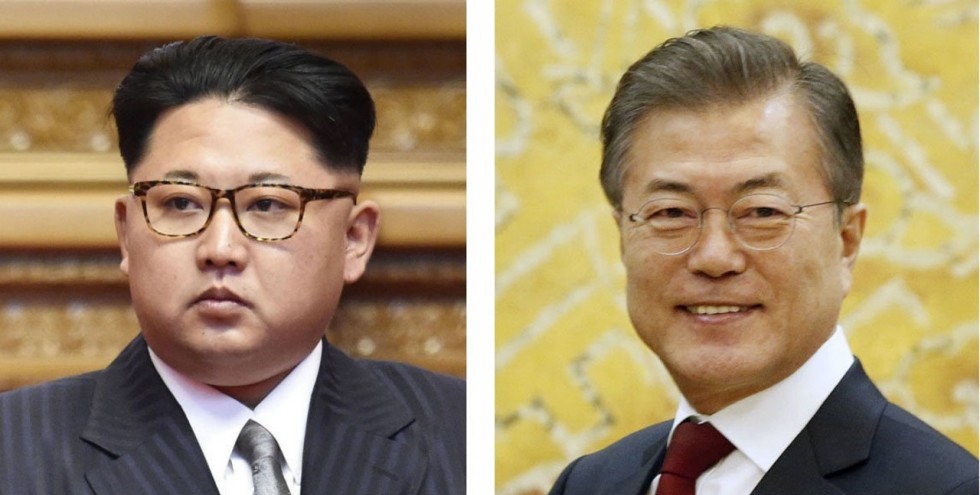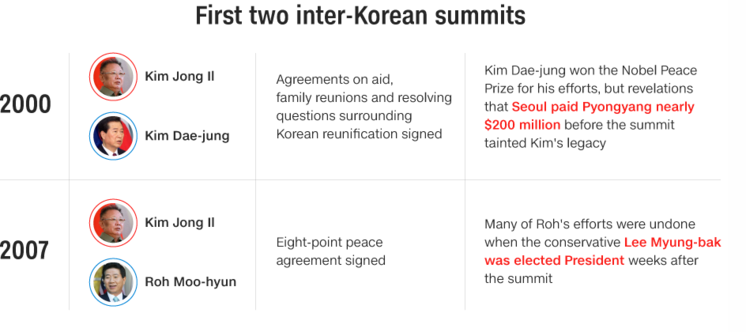The Kim-Moon summit
April 27, 2018 | Expert Insights

Kim Jong-Un and Moon Jae-In are set to meet at a historic summit on the 27th of April. Moon Jae-In may hold some significant advantages that could lead to a positive outcome for these talks. Diplomatic ties between North Korea, and the US and its allies have improved since the beginning of this year. North Korea has indicated that it is willing to discuss denuclearisation.
Background
North Korea was formed in 1945, when colonial Japan withdrew from the peninsula and Korea was divided into two halves along the 38th parallel. In 1950, North Korea, supported by China and Russia, invaded South Korea. The United Nations and US forces intervened on behalf of the South and the invading army was driven out during the Korean War. The two nations signed an armistice in 1953, however, there has been no peace treaty and they are technically still at war.
North Korea’s nuclear programme can be traced back to 1962. The country committed itself to what it called “all-fortressization”, which was the beginning of the hyper-militarized North Korea of today. In 2006, after North Korea conducted its first nuclear test, the UN Security Council passed harsh economic sanctions on the region. However, undeterred, North Korea has continued its nuclear programme. In 2017, it conducted over 20 missile test launches and conducted its sixth nuclear test. It was the nation’s most powerful test yet. According to reports, the country detonated a hydrogen bomb that could be mounted on an intercontinental ballistic missile. US and the UN have sought to impose fresh sanctions on North Korea to exert financial pressure on the nation to force it to back down from its nuclear program.
Diplomatic ties between North Korea and other nations have improved since the Pyeongchang Winter Olympics, which were hailed as the “Peace Olympics” earlier this year. South Korean President Moon Jae-In has told reporters that “North Korea is expressing a will for a complete denuclearization,” which is not conditional on the removal of American troops from the region. Pyongyang agreed to participate in talks with US President Trump later this year, and Kim Jong-Un has reportedly already met with CIA director Mike Pompeo. Earlier this month, North Korea’s state news agency reported that Pyongyang would now stop nuclear tests and ballistic missile launches. According to the KCNA, Kim Jong-un stated that the nation no longer needs these tests as the test site has “finished this mission.”

Analysis
Kim Jong-Un is due to meet South Korean President Moon Jae-in, on the 27th of April, in a historic summit. Moon and Kim will meet at the Peace House in the “truce town” of Panmunjom, in the Demilitarized Zone between the two countries. Panmunjom is where North and South Korea signed an armistice in 1953. Kim Jong-Un’s father, Kim Jong-Il, had met previous presidents of South Korea Kim Dae-jung in 2000 and Roh Moo-hyun in 2007. These presidents adopted a “sunshine policy”, which, according to some, is based on the traditional Korean way of dealing with enemies by giving them gifts to prevent them from causing harm.
Kim Jong-un will be accompanied by nine officials, including his sister Kim Yo-jong and the nominal head of state Kim Yong-nam. Seven officials will join Moon Jae-in, including the ministers of defence, foreign affairs, and unification. “This summit will focus more on denuclearization and securing of permanent peace than anything else,” Moon’s chief of staff, Im Jong-seok said ahead of the meeting.
Analysts have pointed out that this summit has greater potential than either of the two previous meetings. First, corporation between US, South Korea, even China to an extent, is a major difference between Moon’s position and that of his predecessors. Moon has become a symbol of potential reunification in the South, and a middle man between Washington and Pyongyang. He has maintained an important role in ensuring US and Seoul maintain a common stance on the Kim regime. As a result both nations have been firm on denuclearisation. They have been vehement in unwillingness to lift sanctions without some sort of compromise from Pyongyang. However, the question remains, why has North Korea shifted its stance on denuclearisation so drastically?
What are North Korea’s motivations?
Only a few months ago, Kim Jong-Un was exchanging threats with President Trump. In July 2017, North Korea successfully test launched two intercontinental ballistic missiles (ICBM) which it announced was a “gift” to America. In August 2017, it flew a missile over Japan and called it the “first step” in its Pacific operations.
We believe that there are 5 possible reasons for this change in stance:
1. North Korea’s economy is failing: In September last year, the UN imposed its harshest sanctions on the nation yet. There is a ban on textile exports and reduction of oil imports by 30%. Other export bans include coal, iron, lead, and seafood. There is also a ban on hiring North Korean workers overseas. Approximately 100,000 North Korean nationals work abroad; these workers are the second largest source of foreign exchange for the nation. In 2017, it was reported that the country was in danger of famine.
North Korea may be shifting its focus from military to economic development. Economy was a main focus of Kim Jong-Un’s 2018 New Year speech. “We will concentrate all efforts on building a powerful socialist economy and markedly improving the standard of people’s living through the mobilisation of all human and material resources of the country,” North Korea’s official state news agency said in a recent broadcast.
2. The Punggye-ri site: Chinese media have reported that the Punggye-ri site, North Korea’s primary nuclear and missile testing site has collapsed. These reports claim that the site, located under a mountain near the Chinese border, caved in and is leaking radiation. The collapse of the test site could have made Pyongyang aware of the fact that they could not be able to deal with the fall-out of a serious nuclear incident on their own. This could also mean that North Korea’s announcement to end nuclear and missile testing may not have been for any other reason than the fact that the site was unusable.
However, US media and studies have said that the test site was not destroyed, and that it is still operative. Analysts pointed out that North Korea has previously faked damage to its nuclear programme to ease western pressure.
3. China has been putting pressure on Pyongyang: China is one of North Korea’s most influential allies. It has often resisted sanctions against Pyongyang, and Beijing is North Korea’s largest trading partner. However, China does not support Kim’s nuclear programme, and has increasingly participated in international sanctions. In February 2017, China announced that it will be suspending all imports of coal from North Korea until the end of 2017. Pyongyang’s exports to Beijing have reportedly fallen by 35%.
4. Kim Jong-Un wishes to improve his standing: It could be that Kim Jon-Un wishes to normalise his ties with the rest of the world. A summit with the President of the United States would be a key step to attaining some legitimacy, both within his own country, and in the eyes of the international community.
5. Fears of increased sanctions and a threat of attack: It is possible that Pyongyang is finally heeding Washington’s threats. President Trump has threatened nuclear retaliation against the nation. In 2017, he said that North Korea “will be met with fire and the fury like the world has never seen.” Additionally, North Korea may believe that fresh sanctions would damage the economy even further. Even its greatest ally, China, has agreed to participate in sanctions. This could hurt the country’s ambitions, particularly if it has shifted its focus to economy, as speculated.
Assessment
Our assessment is that North Korea may desire the esteem that would come from a meeting with Trump. It would give him both respect and grandstanding in the comity of world leaders. Furthermore, the North and South share deep cultural, historic and familial ties. We believe that the summit between Moon and Kim, could lay the foundation for more productive dialogue in the upcoming Washington-Pyongyang talks. It could help normalise ties between Pyongyang and the international community.








Comments